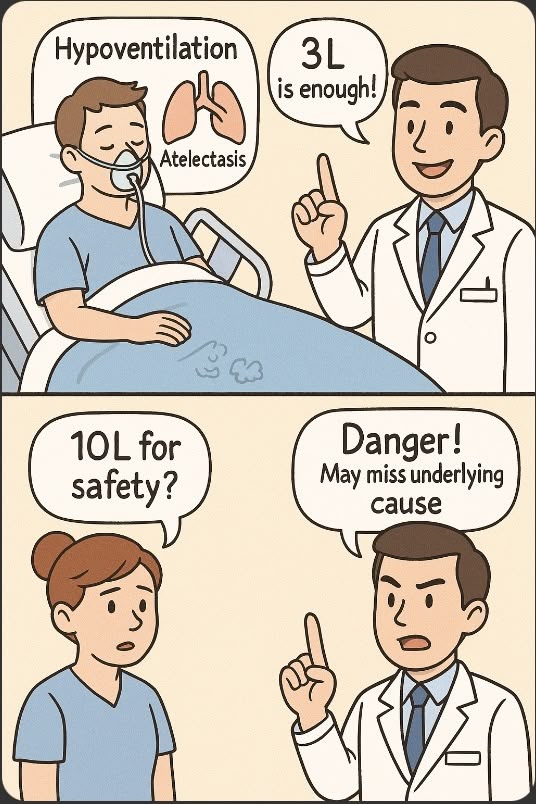👉👉 🇺🇸 All Posts 🇬🇧 / 🇯🇵 記事一覧 🇯🇵 👈👈
♦️ Introduction
“You’ll often hear: ‘Oxygen 3 L/min for 3 hours after surgery.’”
It sounds routine—but why do we actually give oxygen after general anesthesia?
♦️ Why hypoxemia is common after anesthesia
General anesthesia and surgical procedures (especially thoracic and abdominal surgery) significantly impair respiratory function, making hypoxemia more likely. The risk is higher in elderly, obese, or patients with pre-existing respiratory disease.
🔑 Key mechanisms:
- Residual anesthetics → hypoventilation & airway obstruction
- Anesthetics blunt the response to hypoxemia (↓PaO₂) and hypercapnia (↑PaCO₂).
- Elderly and organ-impaired patients are particularly vulnerable.
- Sedatives promote tongue base collapse, leading to upper airway obstruction—oxygen therapy alone is ineffective without airway management.
- Postoperative pain → shallow breathing, poor sputum clearance
- Pain after laparotomy or thoracotomy prevents deep breathing.
- Coughing is painful, impairing sputum clearance.
- Combined with immobility, this promotes atelectasis.
Thus, supplemental oxygen is typically prescribed to prevent hypoxemia in the immediate postoperative period.
♦️ Oxygen is supportive, not curative
Oxygen therapy is symptomatic treatment, not definitive therapy.
It supports oxygen delivery while the underlying cause of hypoxemia is addressed (e.g., pain management, mobilization, airway clearance).
🔷 Why high-flow oxygen is not the answer
It may be tempting to give 10 L/min “just to be safe,” but this is dangerous:
- Long-term high FiO₂ risks oxygen toxicity and CO₂ narcosis.
- Most importantly: high oxygen flow can mask hypoxemia.
- Atelectasis or pulmonary embolism should cause SpO₂ to drop.
- With high O₂, saturation may remain >95%, delaying diagnosis.
If a patient requires high-flow oxygen to maintain SpO₂, this is a red flag—something is wrong and must be investigated.
🔷 Clinical course
Most postoperative hypoxemia improves with time:
- Anesthetics are metabolized and eliminated.
- Pain is controlled with multimodal analgesia.
- Atelectasis resolves with deep breathing and positioning.
Therefore, 3–5 L/min oxygen is usually sufficient for stable patients. Persistent desaturation despite this requires prompt evaluation.

How “routine” is postoperative oxygen internationally?
Across many hospitals worldwide, patients still receive supplemental oxygen immediately after general anesthesia. However, the practice has shifted from fixed prescriptions (e.g., “3 L/min for 3 h”) toward individual titration guided by monitoring.
| Body / Region | Current stance |
| ASA (USA) | Postanesthetic care guidelines call for oxygen as needed with SpO₂/ventilation monitoring; no fixed-dose rule. |
| WHO (Global) | Recommends FiO₂ 80% intra-op and continuation 2–6 h postop in intubated adults for SSI prevention; controversial, variably adopted. |
| EESAIC (Europe) | Practice is heterogeneous; WHO hyperoxia guideline is not consistently followed; trend toward titration and avoiding routine hyperoxia. |
| BTS (UK) | National oxygen guideline emphasizes prescribed SpO₂ targets and titration; avoid unnecessary hyperoxia. |
| ASCRS & surgical societies | High-FiO₂ not routinely recommended for SSI prevention (conditional). |
| Recent reviews | Most postop patients still receive O₂, but emphasis is shifting to lowest effective dose to avoid masking disease and hyperoxia-related harm. |
📝 Summary
- Postoperative hypoxemia is common due to anesthetics, pain, and atelectasis.
- Oxygen is supportive therapy, not definitive treatment.
- Avoid unnecessary high-flow oxygen—it can hide clinical problems.
- If hypoxemia persists despite oxygen, always search for the underlying cause.
- Internationally, practice is shifting from “routine blanket prescriptions” toward titration guided by SpO₂ monitoring.
🔗 Related articles
📚 References & Links
- American Society of Anesthesiologists (ASA). Practice Guidelines for Postanesthetic Care. Anesthesiology. 2013;118:291–307.
- World Health Organization (WHO). Global Guidelines for the Prevention of Surgical Site Infection. Geneva: WHO; 2018 update.
- ESAIC. Practice of Oxygen Use in Anesthesiology — ESAIC Member Survey. 2022.
- British Thoracic Society (BTS). Guideline for Oxygen Use in Adults in Healthcare and Emergency Settings. Thorax. 2017.
- American Society of Colon and Rectal Surgeons (ASCRS). Surgical Site Infection Prevention Toolkit. 2024/25 edition.
- El Maleh Y, et al. Updated meta-analysis on intraoperative FiO₂ and SSI. 2023.
- Wang H, et al. Perioperative oxygen administration for adults undergoing non-cardiac surgery. 2024 review.
- Suzuki S, et al. Oxygen administration for postoperative surgical patients: a narrative review. 2020.

コメントを投稿するにはログインしてください。